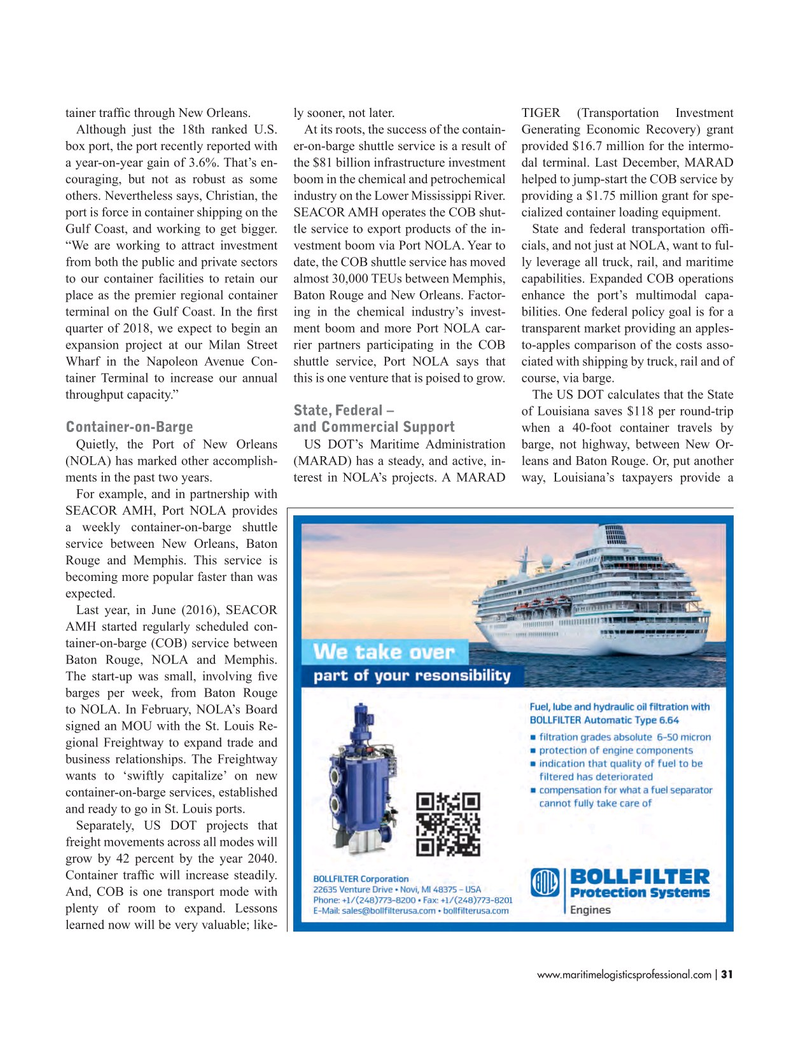
Page 31: of Maritime Logistics Professional Magazine (Sep/Oct 2017)
CONTAINER PORTS
Read this page in Pdf, Flash or Html5 edition of Sep/Oct 2017 Maritime Logistics Professional Magazine
tainer traffc through New Orleans. ly sooner, not later. TIGER (Transportation Investment
Although just the 18th ranked U.S. At its roots, the success of the contain- Generating Economic Recovery) grant box port, the port recently reported with er-on-barge shuttle service is a result of provided $16.7 million for the intermo- a year-on-year gain of 3.6%. That’s en- the $81 billion infrastructure investment dal terminal. Last December, MARAD couraging, but not as robust as some boom in the chemical and petrochemical helped to jump-start the COB service by others. Nevertheless says, Christian, the industry on the Lower Mississippi River. providing a $1.75 million grant for spe- port is force in container shipping on the SEACOR AMH operates the COB shut- cialized container loading equipment.
Gulf Coast, and working to get bigger. tle service to export products of the in- State and federal transportation off- “We are working to attract investment vestment boom via Port NOLA. Year to cials, and not just at NOLA, want to ful- from both the public and private sectors date, the COB shuttle service has moved ly leverage all truck, rail, and maritime to our container facilities to retain our almost 30,000 TEUs between Memphis, capabilities. Expanded COB operations place as the premier regional container Baton Rouge and New Orleans. Factor- enhance the port’s multimodal capa- terminal on the Gulf Coast. In the frst ing in the chemical industry’s invest- bilities. One federal policy goal is for a quarter of 2018, we expect to begin an ment boom and more Port NOLA car- transparent market providing an apples- expansion project at our Milan Street rier partners participating in the COB to-apples comparison of the costs asso-
Wharf in the Napoleon Avenue Con- shuttle service, Port NOLA says that ciated with shipping by truck, rail and of tainer Terminal to increase our annual this is one venture that is poised to grow. course, via barge.
throughput capacity.” The US DOT calculates that the State
State, Federal – of Louisiana saves $118 per round-trip
Container-on-Barge and Commercial Support when a 40-foot container travels by
Quietly, the Port of New Orleans US DOT’s Maritime Administration barge, not highway, between New Or- (NOLA) has marked other accomplish- (MARAD) has a steady, and active, in- leans and Baton Rouge. Or, put another ments in the past two years. terest in NOLA’s projects. A MARAD way, Louisiana’s taxpayers provide a
For example, and in partnership with
SEACOR AMH, Port NOLA provides a weekly container-on-barge shuttle service between New Orleans, Baton
Rouge and Memphis. This service is becoming more popular faster than was expected.
Last year, in June (2016), SEACOR
AMH started regularly scheduled con- tainer-on-barge (COB) service between
Baton Rouge, NOLA and Memphis.
The start-up was small, involving fve barges per week, from Baton Rouge to NOLA. In February, NOLA’s Board signed an MOU with the St. Louis Re- gional Freightway to expand trade and business relationships. The Freightway wants to ‘swiftly capitalize’ on new container-on-barge services, established and ready to go in St. Louis ports.
Separately, US DOT projects that freight movements across all modes will grow by 42 percent by the year 2040.
Container traffc will increase steadily.
And, COB is one transport mode with plenty of room to expand. Lessons learned now will be very valuable; like- www.maritimelogisticsprofessional.com 31
I

 30
30

 32
32
